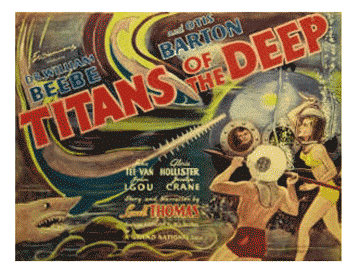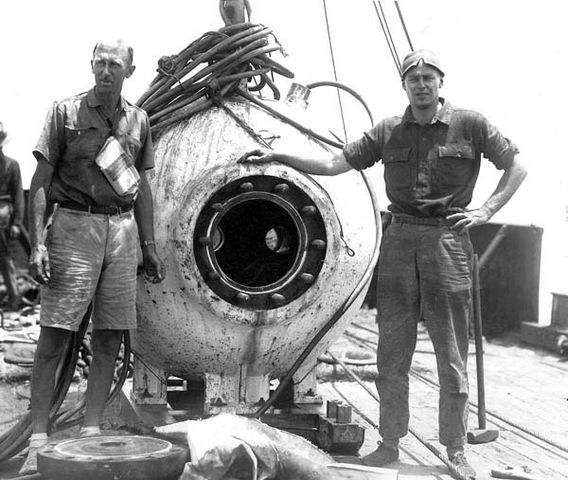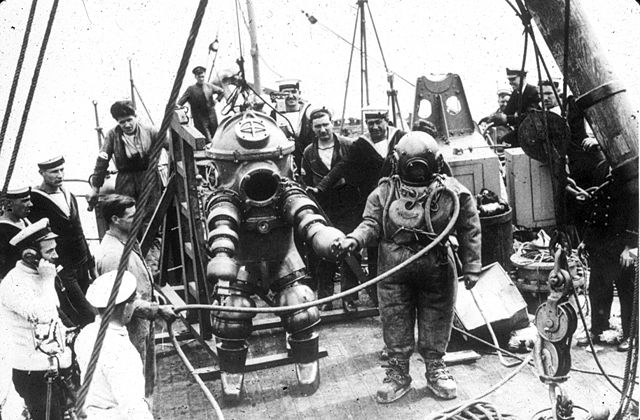
I like science so weird it resembles fiction. While researching anglerfish, I ran across the Bathysphere and found it fascinating that on August 15, 1934, two men descended into depths of the ocean never before traveled.
Background

The first marine biologist to penetrate the perpetual darkness of deep sea, and observe and record deep sea creatures in their natural environment was William Beebe (1877-1962).
Considered one of the great naturalist of the early twentieth century, Bebe made his descend in a huge cast-iron ball attached to a cable. By doing so, he set several consecutive world records for the deepest dives ever performed by a human.
On his first dive, Beebe—in his Bathysphere—went 3,028 feet beneath the ocean’s surface off the coast of Bermuda.
History of the Bathysphere
The Bathysphere, which means deep sphere in Greek, was sketched on a napkin by Colonel Theodore Roosevelt. He and Beebe discussed deep sea exploration. Beebe wanted something simple and not overly mechanical.
Otis Barton (1899-1992), a Harvard graduate with a degree in engineering, also shared a passion for adventure and exploration. He hoped to build a deep sea vessel. After reading about Beebe’s plan and design in The New York Times, he likened Beebe’s design to a laundry boiler. However, he worried Beebe might beat him to the realization of his dream.
Barton had enough money to construct the device, and though well off, he did not have enough money to fund his expedition. He asked to be introduced to Beebe and equated getting an audience with the then Director of the Department of Tropical Research of the New York Zoological Society to that of getting an introduction to an Indian chief, or a “potentate” and “twice as wary”.
Beebe Meets Barton
Crackpot designers, sent by opportunists wishing to join the adventure, inundated Beebe. This delayed Barton’s attempt to facilitate a meeting with Beebe.
When they did meet, Beebe liked the simplicity of Barton’s design and the idea that it was round. Thus, the strong pressure of the deep sea dive would be equally distributed around the ball-like design.
Originally, Beebe had proposed a cylindrical vessel. Barton was leery about a cylinder design and thought it would not withstand the pressure of the depths Beebe hoped to descend.
Barton agreed to fund the construction of the Bathysphere while Beebe secured funding for other expenses. The New York Zoological Society and The National Geographic Society sponsored the first Bathysphere expedition.
Why not a Yellow Submarine?
My question—after I gained this information on the Bathysphere from Beebe’s website and from Wikipedia—was: Why didn’t they use a submarine?

Surprisingly, during this time period, the maximum depth a submarine could submerge was 383 feet. Additionally, the sub had no windows, which made it useless for Beebe’s exploration and documentation of deep sea creatures. The deepest anyone had ventured to date was 525 feet, wearing an armored suit.
The Bathysphere design had three windows made of fused quartz—the strongest transparent material available. Originally, the design allowed for only two windows. However, Barton added a third, which became a steel plug. Before descent, assistants bolted down a 400 pound entrance hatch.
Question Two
How did they get oxygen?
High pressure cylinders inside the sphere supplied oxygen. Trays of soda lime and calcium chloride, attached to the sphere’s walls, absorbed exhaled carbon dioxide and moisture.
And how do you think Beebe and Barton circulated air past these trays? With palm-leaf fans, of course.
The Bathysphere now resides at the New York Aquarium.
As a child I read Jules Vern’s Twenty Thousand Leagues Under The Sea and watched the movie. The thought of exploring the deepest depths of the ocean intrigued me. I now wonder, if Beebe had asked, would I have gone in his Bathysphere?
How about you, would you have traveled in the Bathysphere?
(ProbeNote: Beebe was one of the first early mentors and supporters of women scientists.)
The following You Tube gives a glimpse of the Bathysphere and the Beebe/Barton expedition. It’s eight minutes. The video devotes the first four minute to the Bathysphere. On my scale of 1 to 5, I give it a 5.
- Urban Legend in the Making - April 22, 2024
- Coghlan’s Traveling Coffin Urban Legend - April 4, 2024
- Richmond Vampire Urban Legend - March 7, 2024
